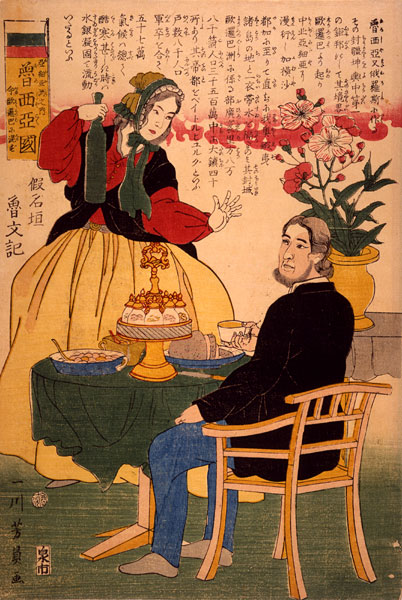
Oroshiyakoku: Ajiya shūno uchi, ima Yōropa ni konzu Title: Russia: On the Asian Continent, Now Associated with Europe Artist: Yoshikazu (fl. ca. 1850-70) 1861 Format: Woodblock print Medium: Ink and color on paper Dimensions: 34.8 x23.9 cm (13 11/16 x9 3/8 in.) Source: Arthur M. Sackler Gallery, Smithsonian Institution The text reads: Oroshiya or Oroshiya [two alternative sets of Chinese characters that represent phonetic transliterations of "Russia" are given]: Among the rich and powerful nations of the world, it is the largest. Its boundaries originate in Europe and extend into central and north Asia as far as Kamchatka, which is separated only by a narrow strait of water from our remote Ezo region. The boundaries with respect to Europe are 88,000 ri [214,720 miles]. There are forty cities for a population of thirty-five million. The imperial city is called Petersburg. It has eight thousand households; its population including soldiers is 570,000. The climate is generally bitterly cold, and it is said that at times it reaches the point of freezing mercury. Recorded by Kanagaki Robun. The journalist Kanagaki Robun (1829-1894) notes in the text that the easternmost territory of Russia is contiguous with Japan's most remote territory, Ezo (modern Hokkaido). Japan's location at the northeastern edge of the Russian empire had encouraged Russian expansionist ambitions long before Commodore Perry successfully negotiated for U.S. trade relations with Japan. The picture depicts a Russian man seated for a meal of bread, sweets, and other dishes. The woman holds a large bottle to serve him an alcoholic beverage. [Adapted from Ann Yonemura, Yokohama: Prints from Nineteenth-Century Japan] Visualizing Cultures image number: Y0115 Keywords: Russia, Russians, Westerners, food, alcohol, flags, Kanagaki Robun, "Five Nations" |
On viewing images of a potentially disturbing nature: click here. |
Massachusetts Institute of Technology © 2014 Visualizing Cultures |